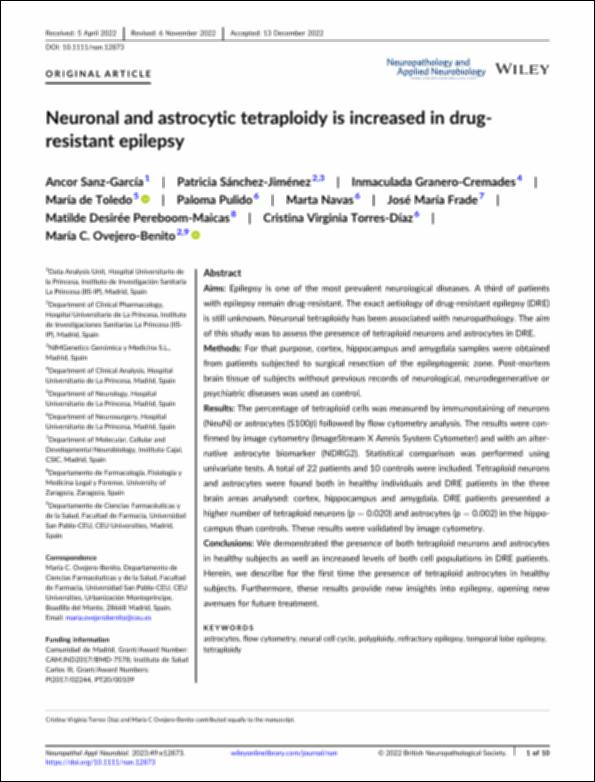Por favor, use este identificador para citar o enlazar este ítem:
http://hdl.handle.net/10637/14119Neuronal and astrocytic tetraploidy is increased in drug-resistant epilepsy.

Ver/Abrir:
Neuronal_Sanz_Garcia_et_al_Neur_Appl_Neu_2023.pdf
2,07 MB
Adobe PDF
Ver/Abrir:
Supp_informat_Sanz_Garcia_et_al_Neur_Appl_Neu_2023.pdf
Anexo
671,77 kB
Adobe PDF
Ver/Abrir:
Suppl_Tables_Sanz_Garcia_et_al_Neur_Appl_Neu_2023.pdf
Anexo Tablas
153,63 kB
Adobe PDF
| Título : | Neuronal and astrocytic tetraploidy is increased in drug-resistant epilepsy. |
| Autor : | Sanz García, Ancor Sánchez Jiménez, Patricia Granero Cremades, Inmaculada Toledo, María de Pullido, Paloma Navas, Marta Frade, José María Pereboom Maicas, Matilde Desirée Torres Díaz, Cristina Virginia Ovejero Benito, María del Carmen |
| Materias: | Astrocytes; flow cytometry; neural cell cycle; polyploidy; refractory epilepsy; temporal lobe epilepsy; tetraploidy |
| Editorial : | Wiley |
| Citación : | Sanz-García A, Sánchez-Jiménez P, Granero-Cremades I, et al. Neuronal and astrocytic tetraploidy is increased in drug-resistant epilepsy. Neuropathol Appl Neurobiol. 2023;49(1):e12873. doi:10.1111/nan.12873 |
| Resumen : | Aims: Epilepsy is one of the most prevalent neurological diseases. A third of patients with epilepsy remain drug-resistant. The exact aetiology of drug-resistant epilepsy (DRE) is still unknown. Neuronal tetraploidy has been associated with neuropathology. The aim of this study was to assess the presence of tetraploid neurons and astrocytes in DRE. Methods: For that purpose, cortex, hippocampus and amygdala samples were obtained from patients subjected to surgical resection of the epileptogenic zone. Post-mortem brain tissue of subjects without previous records of neurological, neurodegenerative or psychiatric diseases was used as control. Results: The percentage of tetraploid cells was measured by immunostaining of neurons (NeuN) or astrocytes (S100β) followed by flow cytometry analysis. The results were confirmed by image cytometry (ImageStream X Amnis System Cytometer) and with an alternative astrocyte biomarker (NDRG2). Statistical comparison was performed using univariate tests. A total of 22 patients and 10 controls were included. Tetraploid neurons and astrocytes were found both in healthy individuals and DRE patients in the three brain areas analysed: cortex, hippocampus and amygdala. DRE patients presented a higher number of tetraploid neurons (p = 0.020) and astrocytes (p = 0.002) in the hippocampus than controls. These results were validated by image cytometry. Conclusions: We demonstrated the presence of both tetraploid neurons and astrocytes in healthy subjects as well as increased levels of both cell populations in DRE patients. Herein, we describe for the first time the presence of tetraploid astrocytes in healthy subjects. Furthermore, these results provide new insights into epilepsy, opening new avenues for future treatment. |
| URI : | http://hdl.handle.net/10637/14119 |
| Derechos: | http://creativecommons.org/licenses/by-nc-nd/4.0/deed.es openAccess |
| ISSN : | 1365-2990 (Electrónico) |
| Cubierto por: | Acuerdo Transformativo -2023 |
| Fecha de publicación : | 10-ene-2023 |
| Centro : | Universidad San Pablo-CEU |
| Aparece en las colecciones: | Facultad de Farmacia |
Los ítems de DSpace están protegidos por copyright, con todos los derechos reservados, a menos que se indique lo contrario.

